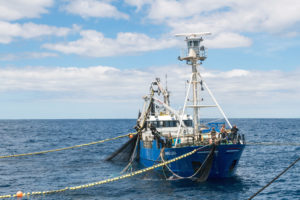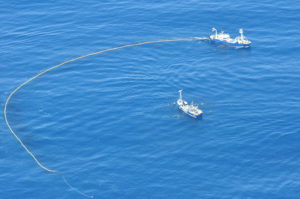 The tuna industry is intricately orchestrated and powerfully driven, fighting against the rough waters of the Great Australian Bight. It relies on an awesome demonstration of teamwork, with each step relying on the successful completion of the one prior. Years of experience, research and attention to detail feed into the practice, yielding world class, premium quality product.
The tuna industry is intricately orchestrated and powerfully driven, fighting against the rough waters of the Great Australian Bight. It relies on an awesome demonstration of teamwork, with each step relying on the successful completion of the one prior. Years of experience, research and attention to detail feed into the practice, yielding world class, premium quality product.
Typically it all starts with the spotter plane. Flying above the Great Australian Bight, a pilot searches for schools of tuna. Using an expert eye they estimate the average size of the tuna and the quantity, attempting to identify which patch will be the most promising. The information is relayed to the skippers of the tuna boats which race to the patch of fish, hoping to catch them before another company.
Tuna are caught by purse seine, which in simple terms involves surrounding a school of fish with a net. However, this process is far from simple. One boat, called the Chum boat, releases masses of baitfish (typically sardines) into the surrounding ocean. Tuna are predatory fish and swarm the boat, feeding on the bait. From the deck, the crew visually double-check the size estimates of the school. If the sizes are agreeable, the next step can begin.
 A second boat, known as the seiner, releases the purse seine net into the ocean and circles the Chum boat. The net hangs vertically in the water with its bottom edge held down by weights and is top edge buoyed by floats. Once a ring of net successfully surrounds the tuna and Chum boat, the Chum boat exits via a pre-existing gap.
A second boat, known as the seiner, releases the purse seine net into the ocean and circles the Chum boat. The net hangs vertically in the water with its bottom edge held down by weights and is top edge buoyed by floats. Once a ring of net successfully surrounds the tuna and Chum boat, the Chum boat exits via a pre-existing gap.
Now a few more boats enter the mix. A number of tinnies attach a rope to the net, holding it in place. The seiner boat pulls in the net to make the circle smaller whilst the tinnies work at maintaining the structure. The aim is to encourage the school to bunch, but without causing too much stress in the fish. Next, a certified diver joins the school. The diver triple-checks the size estimates and reports to the skipper on the seiner.


If all is going according to plan, a third boat, known as a towboat, is called upon. The role of the towboat is self-explanatory; it carries a tow cage used to transport tuna. Skilled skippers and crew align the tow cage alongside the purse seine net such that the gates on each net match. The seiner boat pulls in their net slowly, encouraging fish to naturally transfer from the fishing net to the tow pontoon with low stress. A diver is stationed at the gate, counting the fish as they move through.
Once the tow cage has approximately 10-15,000 fish the gates are dropped. With the tow cage attached and tuna inside, the towboat travels back to Port Lincoln at a maximum speed of one knot. Such a slow speed minimises the damage done to tuna within the cage.
In the waters behind Boston Bay awaits static tuna cages into which the tuna must be transferred. First an average weight of the tuna within the tow cage is determined via sampling 100 tuna and recording their weights. From the tow cage to the static cage the tuna are moved, in a process similar to that described above.

A camera is set up by the gate, filming the fish as they move through. Later an auditor manually counts each individual fish, determining the number that is in each cage. By multiplying the number of fish by the average weight the company knows how much of its quota it has caught, and thus how much is left.
The prized Southern Bluefin Tuna are fed a diet of baitfish over a period of 4 to 5 months, during which time the fish grows, maximising its colour, texture and flavour. The aim is to double the weight of the fish. Additionally, as winter approaches, the waters cool and tuna begin to build up fat. It is these fatty reserves that are celebrated in the world of sashimi.
The goal is to have the first time that the tuna are touched be at harvest. Harvesting of the tuna is swift with unparalleled attention to detail. The aim is to minimise stress in the fish since upon stress lactic acid is released into the tuna’s system, which influences the flavour of the fish. By reducing the stress felt by the fish, the quality and the integrity of this product is maintained to the highest standard.
First around 100 fish in the static cage are sectioned off using a net. Next, divers manually capture individual fish and guide them onto platforms that lead to the deck of the boat.
Within 10 seconds of being out of water the fish are euthanised humanely, by a spike into their brain. This method, known as “iki jime” in Japanese, has been perfected over time to minimise stress. After being euthanised, the tuna is gilled, gutted and wired. The wire is fed down the nervous system, disabling it and preventing any post-mortem twitching that would affect the tenderness of the fish. Tuna are immediately transferred into an ice slurry or refrigerated sea water in order to keep fish fresh. From start to finish, only 40 seconds has passed. The speed of the process maintains premium quality.
On board the tuna harvest boats are representatives of Japanese companies who scrutinise the product before export. They look for good shaped fish that have suffered no damage in the harvesting process. A segment is taken from the tail to determine quality. A strong, deep red colour and good fat deposits are considered extremely favourable. Quality and colour of SBT muscle flesh is assessed 3 times prior to the sale of a fish. SBT are graded according to their size and body shape, oil content, flesh colour, and absence of defects (e.g. indicators of poor handling).
Fresh Southern Bluefin Tuna can be flown to Japan to be in the markets in Japan within 48 hours of harvesting and processing. Otherwise tuna is super-frozen at minus 60C. The majority of frozen fish is sent to Japan; however, some is kept for domestic markets.

Watch the video below for a “real” experience on what it’s like out on the boats
https://www.youtube.com/watch?v=hVsLZAT0AqY
